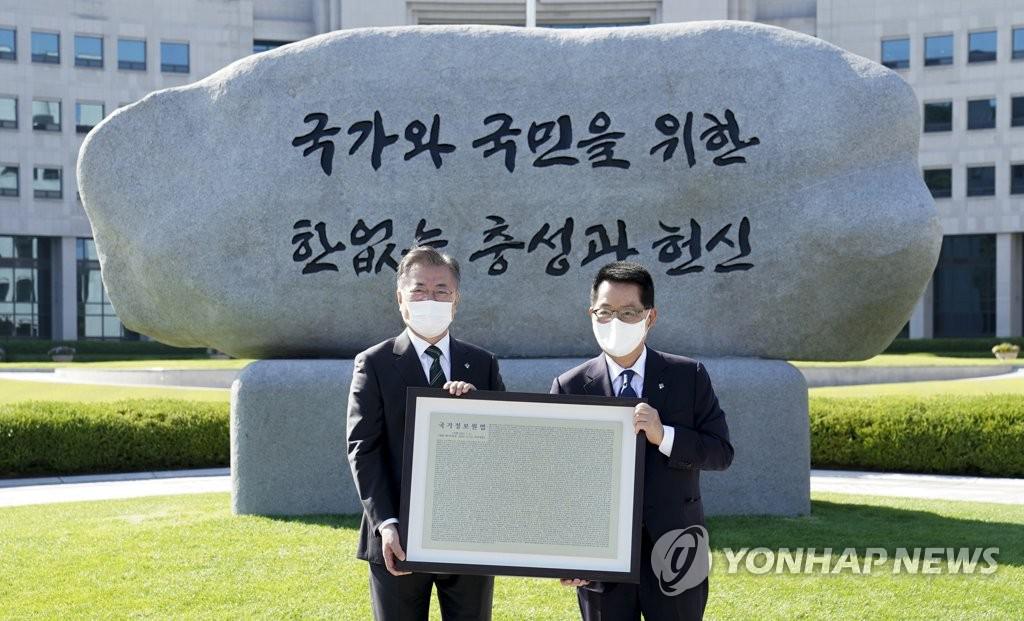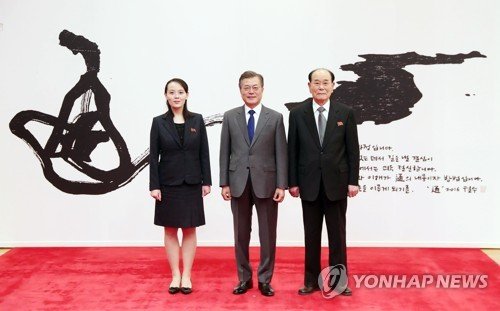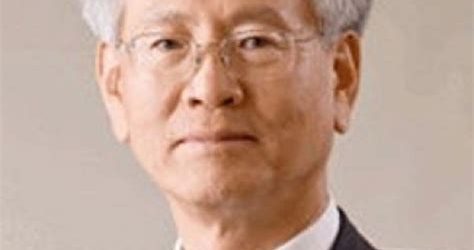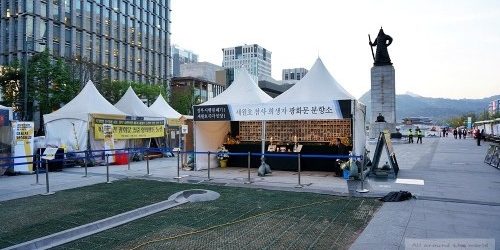Communist Spy Shin Young-bok of Subversive Revolutionary Organization Memorialized at South Korea’s Intelligence Agency, An Insult to NIS and the Republic of Korea
Tara O, 2022-6-6
Imagine a statue of Aldrich H. Ames at the entrance of the CIA. Or a memorial of Robert Hanssen at the entrance of the FBI. Does it make sense to establish tributes to spies who damaged U.S. national security, especially in front of the CIA and FBI headquarters? In the Republic of Korea (ROK), that is exactly what has happened. On June 4, 2021 during the Moon Jae-in administration, such a tribute to a communist spy—Shin Young-bok (신영복)—was established when Shin’s calligraphy was engraved on a large rock at the entrance of the National Intelligence Service (NIS), which is like the CIA of the U.S.

Shin Young-bok and the Revolutionary Unification Party (TongHyukDang)
Shin Young-bok was sentenced to life in prison by South Korea’s Supreme Court for violating the National Security Act for his anti-state espionage activities. After 20 years in prison, he was granted special parole in 1988 and released.
North Korea indicated how important Shin was to them by offering to exchange three South Korean officials for one person—Shin Young-bok. After Vietnam was communized by Ho Chi Minh, South Korean officials based in Vietnam were captured and imprisoned by the communist government in Vietnam. In 1978, 3 years after the fall of Vietnam, North Korea offered to have three South Korean officials who were detained in Vietnam prison be released to South Korea in exchange for sending Shin Young-bok to North Korea. South Korea refused on the “principle of protecting its citizens,” even if the officials were treated as criminals and jailed in Vietnam.
Shin Young-bok was crucial to the formation and subversive operations of the Revolutionary Unification Party (RUP, 통일혁명당), an underground organization and an extension of North Korea’s Workers’ Party. Uncovered in 1968 by the South Korean government, the Revolutionary Unification Party case was the most significant espionage case in the 1960s.
Note: Revolutionary Unification Party (RUP) is Tong-il Hyukmyung Dang (통일혁명당), which is abbreviated as TongHyukDang (통혁당).
The Revolutionary Unification Party was created in the mid-1960s in South Korea on the order of North Korea in order to overthrow South Korea’s free democratic system through an armed revolution. Its creed and beliefs were in line with North Korea’s Workers’ Party, since it is an extension of it: The RUP maintained that South Korea is a colony of the U.S. and the Korean people by themselves should establish a revolution to expel the U.S., overthrow the South Korean government, and establish socialism. [1] “Armed with Marxism and Leninism,” RUP sought to establish so-called “democracy”—not the liberal democracy of South Korea, but socialism after going through “democratic society.” It labeled the U.S. as an imperial power with control over South Korea and referred to the South Korean government as “fascist,” the words/phrases often repeated by North Korea as well as South Korea’s far left. In using such words as “democracy,” “fascist,” and “imperialism” to mislead the public, they are using Terminology Confusion Tactics. See here for more details.
TongHyukDang’s (RUP’s) key leaders, such as Kim Jong-tae (김종태), Kim Jil-lak (김질락), and Lee Moon-kyu (이문규), secretly went to North Korea, joined the Korean Workers’ Party (NoDongDang), received espionage training and money from North Korea, returned to South Korea to conduct subversion, and reported their activities to Kim Il-sung.
The details of their visits to North Korea and their activities are published in The Death of an Intellectual, written by Kim Jil-lak, one of the key leaders of RUP, while incarcerated. For instance, Kim Jil-lak details how he recruited Shin Young-bok, then a young professor, who was already radicalized at the time and tried to inculcate his students with class consciousness of Marxism. Shin told Kim, “when I give a lecture to students, I imbue class consciousness to them by using simple and interesting words.”[2] Shin Young-bok suggested to Kim that he should start his subversive activities several months later, since he would soon join the military and upon completion of basic officer training, would teach at the ROK Military Academy. TongHyukDang had two main operational departments: National Liberation Front (Minjok Haebang Jeonseon, 민족해방전선) and Motherland Liberation Front (Joguk Haebang Jeonseon, 조국해방전선). Shin worked in the National Liberation Front within the Unification Revolutionary Party, and was the Senior Secretary for Organization.
The National Liberation Front organized 8 “circles”—clubs within universities—including the “Christian Youth Economic and Welfare Society” (기독청년 경제복지회), the “New Cultural Research Society” (새문화연구회), the “Association of Youth Writers” (청년문학가협회), the “Buddhist Youth Society” (불교청년회), the “Oriental Society” (동학회), the “Nationalist Research Society” (민족주의연구회), the “Case Society” (경우회), and the “Cheongmaek Society” (청맥회). These 8 circles were mass organizations, and the leaders of the circles recruited people from these circles to form “party cells” of three to form compartmented underground organizations to carry out the tasks of the Unification Revolutionary Party. This type of underground, compartmented “3-person cells” continued to be a model for future underground revolutionary organizations, such as MinHyukDang (민혁당), Joongboo JiyeokDang (중부지역당), and IlSimHoe (일심회), which is described in detail in the book The Dark Side of Progressivism: South Korea’s Underground Revolutionary Organizations and North Korea by Han Gi-hong (한기홍), a former student activists and labor activists.[3]
In June 1967, Shin recruited Park Sung-jun (박성준), who led the “Christian Youth Economic and Welfare Society.” Park then recruited Han Myung-sook and married her later. Han eventually became the prime minister of South Korea during the Rho Moo-hyun administration. She was brought into politics as a proportional representative (not-elected) by Kim Dae-jung, who appointed her as the minister of the newly created Ministry of Women (여성부) (now the Ministry of Gender Equality in English, but called the Ministry of Women and Family in the Korean language).
As the Korea CIA (KCIA, now NIS) and other counterespionage authorities began to uncover more evidence and the RUP seemed to be closer to exposure, North Korea sent an armed spy ship belonging to North Korea’s unit 153, which arrived on Jeju Island on August 20, 1968 to pick up the key leaders of the Revolutionary Unification Party. It failed, when they engaged in an armed fight against the South Korean military. Twelve North Korean agents (out of 14) were killed and two agents were captured, and 158 RUP members were arrested, with five main criminals receiving death sentences. Shin Young-bok received a life sentence. Shin was released after signing a confession letter stating his conversion in ideology from communism and Kim Il-sungism, but later he stated, “I never changed my ideology nor betrayed my comrades.”
Shin then taught as a university professor and created his own style of calligraphy, “Shin Young-bok che.”
Moon Jae-in’s admiration for Shin Young-bok
Moon Jae-in has stated publicly that Shin Young-bok is the ideologist he admired the most in his welcome address at the reception of the Pyeongchang Winter Olympics in 2018 when he was president. Kim Moon-soo, former governor of Gyeonggi and former labor activist, criticized Moon, stating, “Shin Young-bok is clearly a spy, and I don’t think the president of our country should say to the whole world that he respects the ideology (Marxism-Leninism-KimIlSungism) of such a person.”

Moon proved his admiration for Shin not only in his speech, but also when he used Shin’s calligraphy style as a giant wall hanging at the Blue House during the PyeongChang Winter Olympics in 2018. Moon told Kim Yo-jong that the wall hanging is of Shin Young-bok’s calligraphy and suggested taking commemorative photos. Kim Moon-soo said he was horrified.
Professor Emeritus Yang Dong-an (양동안) also stated that Shin Young-bok, who Moon admired, was thoroughly a communist based on his writings and actions. This was one of the points emphasized in a testimony at a trial, in which Moon Jae-in sued Koh Young-ju, because Koh called Moon a communist.
Motto Rock with Spy’s Calligraphy Unveiled
Former NIS employees condemn
When the new motto rock, referred to as Wonhoonseok (원훈석), was first unveiled in the main courtyard of the NIS in June 2021, former NIS employees were furious, calling it “an attempt to punish the NIS,” and demanded that “the motto rock with Shin’s calligraphy be replaced” and Moon Jae-in’s then-director of NIS Park Jie-won (박지원) be dismissed. They held multi-day protests to condemn the tribute to Shin. On June 24, 2021, they issued a statement (excerpts):
“Director Park Jie-won de facto neutralized the country’s premier intelligence agency by transferring the authority of counter-intelligence investigation, including the tracking of North Korea’s espionage infiltration, to the police. He followed up (the neutralization of NIS) by replacing the Wonhoonseok typeface with ‘Shin Young-bok-calligraphy.’ These serialized acts are aimed at punishing the NIS in order to destroy the mental foundation of the NIS staff in a way that makes NIS a paper tiger that only exists formally, but is unable to carry out its national security functions.”
“(Shin Young-bok) is a representative Kim Il-sung-ist, who played a pivotal role in the formation and activities of the Revolutionary Unification Party, which was formed in 1968 under the direction of North Korea for the purpose of overthrowing the liberal democratic system of the Republic of Korea, and [Shin] has already been judged as such by the Supreme Court’s affirmative ruling.”
“(Engraving the motto rock with Shin Young-bok’s calligraphy) is tantamount to bringing North Korea into the courtyard of the NIS, which is an act of treason that aids the enemy (이적행위).”
Freedom Coalition to Protect the National Security Act Condemns
Another group, Freedom Coalition to Protect the National Security Act (국가보안법수호자유연대), condemned the unveiling of the rock at a press conference on June 10, 2021 in front of the NIS headquarters in Seoul. They stated:
“The unimaginable act of undermining the identity of the National Intelligence Service, which is responsible for national security, is now occurring in the Republic of Korea.”
“Today is the 60th anniversary of the establishment of the NIS. [Instead of celebrating and honoring its anniversary], however, the NIS inscribed its motto on the NIS symbol Wonhoonseok (motto rock) with the calligraphy of Shin Young-bok, a spy of the TongHyukDang.”
“[NIS, which] captures spies is now symbolized by a spy.”
“The desecration of Wonhoonseok (motto rock) with a spy’s calligraphy by the President [Moon Jae-in] and the NIS Director [Park Jie-won], who are supposed to defend the country, is insulting to the Republic of Korea and wangling of the people.”

Recently on May 16, 2022, another civic organization continued to denounce the tribute to the spy. The Freedom Coalition in Defense of the National Security Act (국가보안법 수호 자유연대), is comprised of 103 NGOs, and is led by Dr. Yoo Dong-ryul (유동열), who is also the director of the Korea Institute for Liberal Democracy. The Coalition demanded an “immediate tearing down and destruction of the spy calligraphy-engraved Wonhoonseok at NIS.” It also stated:
“Having a spy’s calligraphy on Wonhoonsuk is a complete disdain and denial of the soul of the NIS, which defends the free Republic of Korea, and the identity of the Republic of Korea.”
“The unveiling of Wonhoonsuk engraved with the spy’s calligraphy style at the NIS in broad daylight must be investigated thoroughly, the list of the officials involved must be disclosed immediately, and (the officials) brought to justice under the law.”
As of this writing, the “spy calligraphy rock” still stands prominently at the Republic of Korea’s National Intelligence Service.
[1]Kim Jil-lak. An Intellectual’s Death: Kim Jil-lak’s Writings while Incarcerated, 2nd ed. Hangrim Seowon: Seoul, 2011, 12.
[2] Ibid, 105.
[3] Han Gi-hong. The Dark Side of Progressivism: South Korea’s Underground Revolutionary Organizations and North Korea. Shidae Jeongshin: Seoul, 2012.





